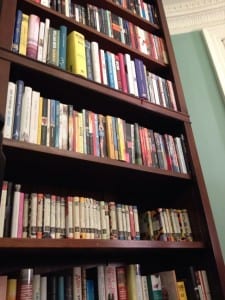Esther Freud’s Book Club by Caroline Murphy
By Anne Welsh, on 3 October 2014
I’ve never actually been to a book club before. My reading career started, and continues to progress in armchairs, duvets, and trains. However, the UCL Centre for Publishing has been throwing new experiences at me left, right and centre since I began, and one happened to be my first book club … at the Bloomsbury Institute, no less!
Four other students and I were offered the opportunity to be hosted by Bloomsbury in their offices in Bedford Square for an evening of discussion with Esther Freud. Freud is the great granddaughter of the famous psychoanalyst, and her eighth novel, ‘Mr Mac and Me’, comes 22 years after her debut ‘Hideous Kinky’ in 1992. The evening promised to be a eye opening event and after a bite to eat, we set off for Bedford Square.
The great thing about the interior of the Bloomsbury building is that it isn’t the usual setting for an office. It’s a huge town house where the corridors twist and turn, and are separated by rooms with high ceilings and wide doors. We were directed from the foyer into a conservatory, beautifully decorated with white fairy lights. We were then offered complimentary wine, which has set the standard in my mind for all other publishing events! The buzz started to grow as more people shuffled in. After purchasing Freud’s novel, having our glasses topped up, and having a few snaps of our best ‘in-the-moment’ poses taken by the Bloomsbury photographer, we all took our seats.
Esther Freud is a trained actor: her diction is incredible, and much like her writing, she speaks with great fluidity, clarity and ease. In conversation with Bloomsbury’s Editor-in-Chief, Alexandra Pringle, she recounted the events that brought her to creating ‘Mr Mac and Me’, including her relocation to Suffolk, and the history she discovered in doing so.
The novel itself follows the tale of the Glaswegian artist and architect Charles Rennie Mackintosh, famous for his art deco designs such as the Glasgow School of Art and Hill House in Helensburgh. Having seen some of his works myself, I was intrigued to learn more. The novel follows his years in Suffolk, when his work was underappreciated and unaccredited, and his drinking habits were escalating.
Freud’s composition of this novel demonstrates that serendipity in writing exists: you often find something brilliant when you’re not looking for it. She set out to write a chilling ghost story, but continued in a direction she didn’t expect, and ended up with the detailed historical account that sits on my desk in hardback as I write this blog post.
After hearing a short excerpt from the novel, the evening drew to a close, and we queued for our signings, whilst gawping at the Platinum Book Awards earned by nearly all of the Harry Potter books. The evening was thoroughly enjoyable, with great advice from a great author, complimentary wine, and floor to ceiling bookshelves.
Thanks, Bloomsbury Institute and UCL Publishing!
—–
Caroline Murphy (@carolinealice93) is studying for her MA in Publishing.
Image: Caroline Murphy on Twitter.
Note: the appearance of the byline on this post is auto-generated, indicating that it was posted by Anne Welsh. Caroline Murphy is the sole author of this piece.
 Close
Close


